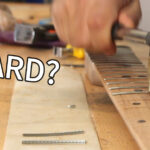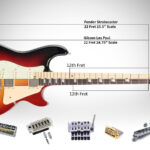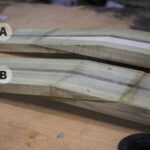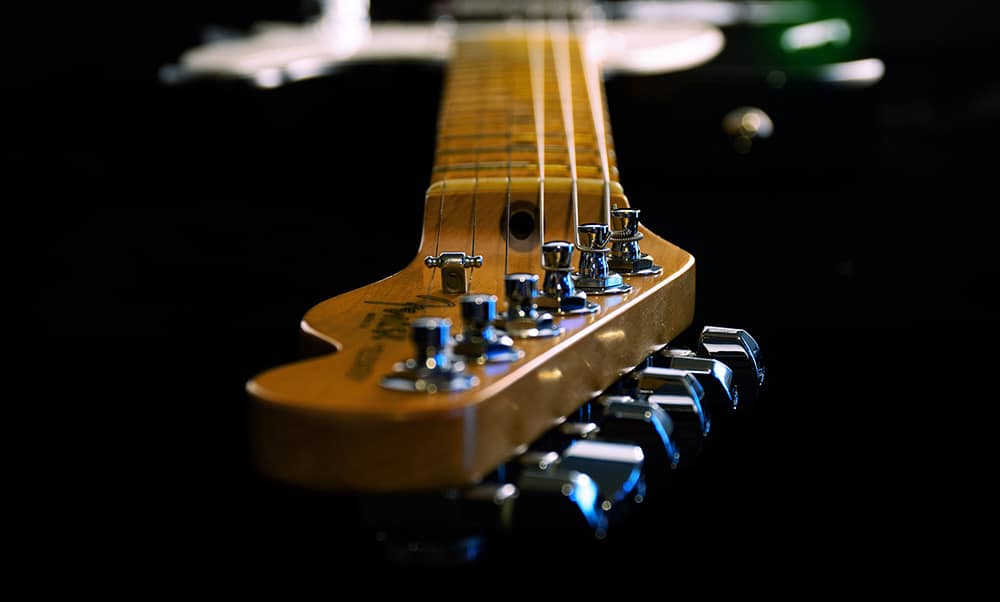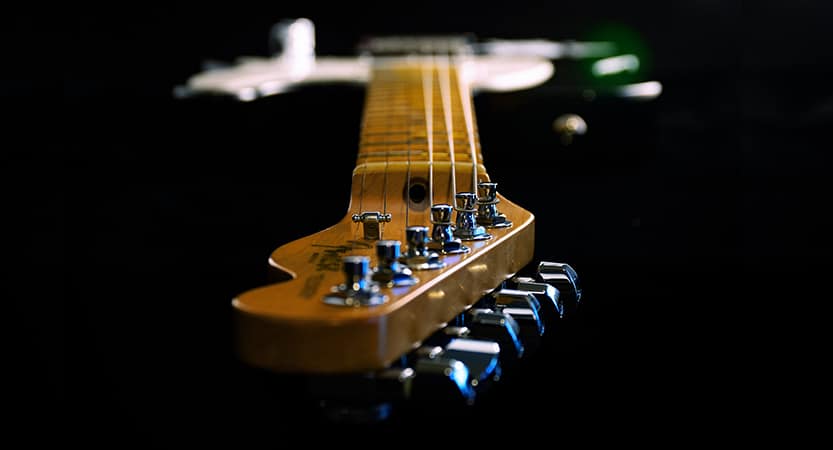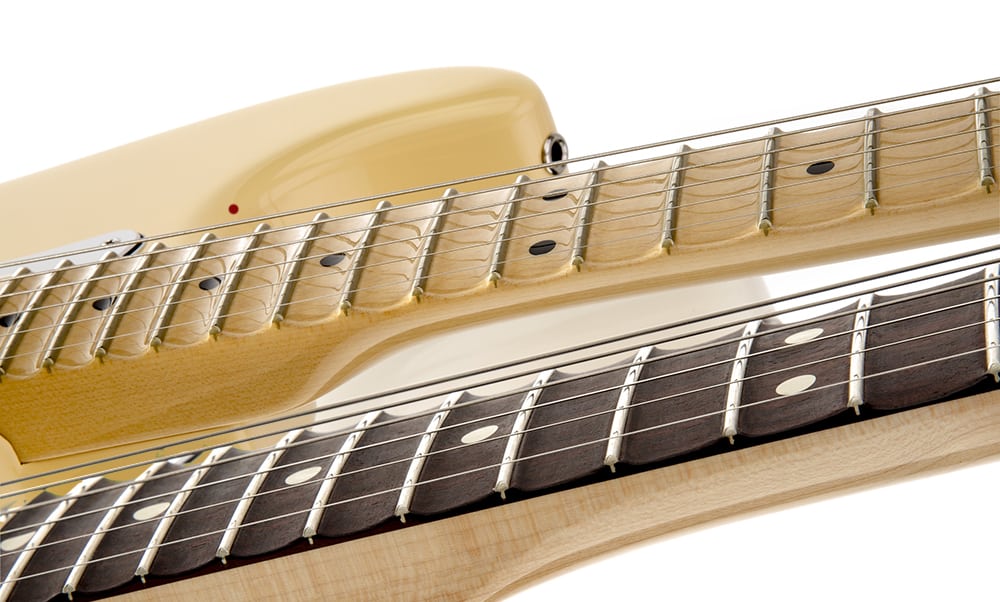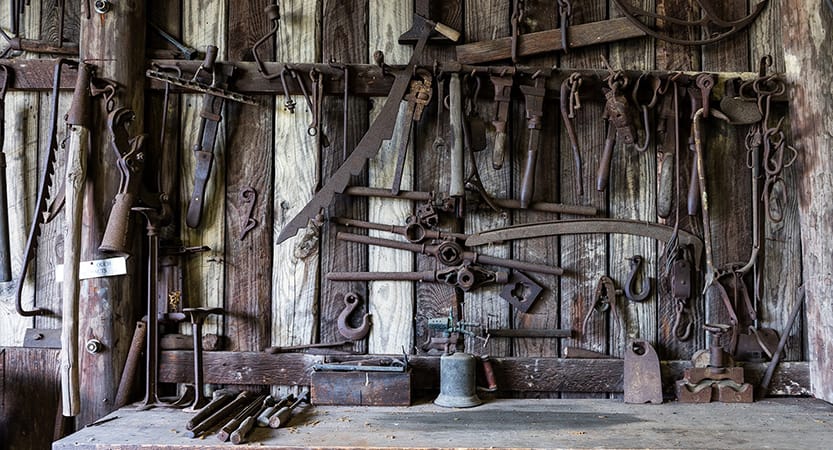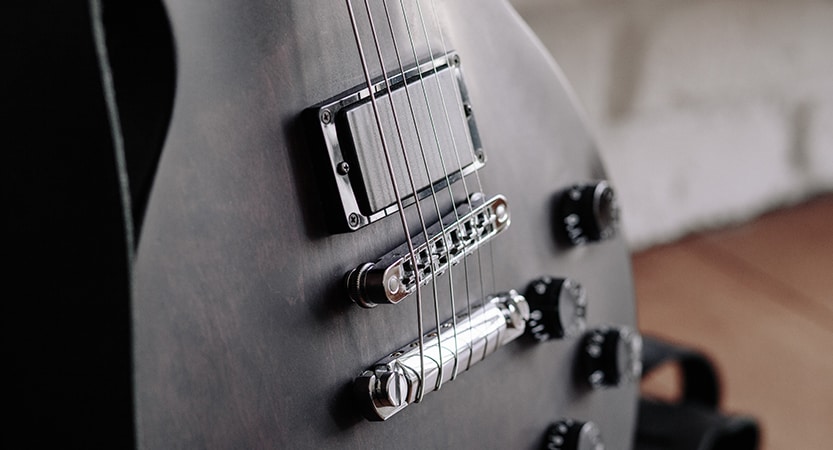When building a guitar, you will also have to make a choice regarding the headstock. Headstock come in various sizes, shapes and designs and are on e of the more visually prominent parts of the guitar. There are different ways to construct the headstock and picking the right one for you will naturally make a big difference on the aesthetics of the guitar but will also effect the strength, the construction methods, the material and parts you use.
We’ll take a look at all aspects of the headstock and see what effect it will have on your future guitar. By the end of this article you should better understand the different methods of building your headstock, picking out the shape and avoiding some common pitfalls and issues which may rise. The headstock can be simple and functional but can also serve as a beautiful ornamental part of the guitar.
The headstock role
First and most important function of the headstock is to house and support the tuners AKA the machine heads or tuning pegs. In most guitars the string run from the bridge, where they are stationary, to the tuners where they are connected and tightened. Six metal strings create a lot of force pulling on the tuners and the headstock. A strong headstock will have a direct effect on tuning stability
Being the point of connection of the strings, the Headstock will also have an effect on the the guitar’s sustain. Softer materials will dampen the strings’ vibrations and tend to give a shorter and muddy sustain. The more rigid the headstock, the longer the vibrations will last and the better sustain you will get.
Types of headstock
The two main types of headstock available on electric guitars are the Flat Headstock and the Angled or Tilted Headstock. Different companies and guitar makers have many variations and angles to these two basic types, each with their own reasoning and methods. Let’s look and understand what stands behind them.
Flat Headstocks
When Leo Fender set out to build a production guitar, (back in the 50’s) he looked for strength, efficient use of lumber and ease of production. After a few attempts, the outcome was the flat Telecster headstock.
The benefits of the flat are just those:
If using proper lumber or a multi-laminated neck, it should be very strong, and since the headstock is just a straight the end of the same piece, it has the same strength.
Without the typical angle and heel, all you really need, in terms of wood quantity is less than inch (or about 20mm) of material.

The only real downside is the very low angle you will have between the nut and the longer string. Typically on Fenders these would be the ones on the lower side of the guitar (high E side), but on other headstock it would just be the ones that end up reaching longer to the end of the headstock. Aside from aesthetics and inconsistency of the angle with other string (which have no real significant effect on sound) , too shallow an angle may not put enough pressure on the nut and therefore may cause strings to pop out of place in extreme bends or give a buzz.
There are a few ways to deal with these drawbacks:
- The first and most common one is ‘string trees’: These are little pieces of metal which are screwed to the headstock and hold down the strings, bending them to form a sharper break angle and more tension at the nut.
- Another quite similar, solution is a ‘String Retention Bar’, which functions much the same as the Tree, but effects all of the strings at once. The string retention bar will give all the strings the same angle and is most commonly used in conjunction with a Floyd or Other Locking Nuts and will help hold the string low enough , relative to the metal nut so that when pressure is applied on the screws it will not pull on the strings and change the intonation. If you are not using a locking nut, you probably don’t need all the strings to be adjusted and a regular tree will do the job.
- The more sophisticated solution is using staggered tuners. These will have shorter pegs the further you get from the nut to compensate for the smaller break angle and eliminate the need for trees altogether
Angled Headstock
Traditional classic and acoustic guitars all had angled necks and it does seem the obvious way to go. You will get a bigger break angle on the nut and a much more consistent one for all strings as well.
The traditional one-piece method
Not all is perfect and traditional Angled Headstocks which are built from a single piece of lumber suffer two drawbacks:
The angle causes the grain, which runs along the neck for strength, to be cut diagonally and leave a very weak area along the headstock. Many headstocks have been broken this way when a guitar was hit or dropped.

For this reason, there is a second construction methods for angles headstocks:
The ‘Scarf Joint’
Using a ‘Scarf Joint’. The scarf joint is created by using a flat (thinner) piece of lumber and after cutting it diagonally, the headstock piece is flipped and glued to create a headstock that has the grain running parallel to its face, maintaining the strength and integrity of the wood.

Both methods can also be carried out using a multi-laminated neck blank which will give better overall strength and minimize warping.
What Angle should I use?
Here is another issue where opinions are divided, it works either way and most people would probably not notice the difference anyway. Starting and leading the trend were Gibson with 17 degrees Over time they did change to 14 degrees but its unclear if it was for strength (a lot of Gibson headstocks were breaking), economics or tone. Other makers use 13, 12 and 10 degrees and all seem to fine. There are many arguments about tone, tension, sustain, and they are often mixed with terminology from physics. They only thing I have found to be absolutely true is the practicality of the strings holding on and not slipping when pulled and bent. What really matters is the angle of the strings and not the headstock and since we know that somewhere between the 4th and the 5th string on Fenders is where you need the trees to avoid ‘slippage’ I think that would be the minimal angle. Now if you like any more than that for aesthetic or sentimental reason, please go for it, but I could not find any substantial evidence that supports the need for a steeper angle.
Dealing with Tremolos
In opposition to general playing which warrants a significant break angle of the strings from the nut to the tuners, the tremolo or vibrato systems actually function better with smaller break angle. The tremolo pulls and releases the strings and will work more smoothly with strings that can glide in the nut with the least amount of resistance. The higher the break angle the more pressure the strings will have on the nut and the bigger the friction. Two approaches to overcome this problem is either is either aid the smoothness of the nut by lubricating it or actually putting some fine graphite between the string and nut or eliminating it altogether. The second option is becoming more common and is pretty much a part of vibrato systems such as Floyd Rose or similar ones. Locking nuts just hold the strings in place and take the headstock and tuners out of the equation in everything that concerns the tremolo or loss of tuning. As known to Strat users, extensive use of the tremolo will affect the tuning faster than regular playing. If you already have a flat headstockWhat about top view angles for the strings?
The sideways angle of the strings should not make any real difference to the tone, just like the break angle. However, it does increase the pressure and therefore the friction of the string in the nut. This should not make a real difference to the tone or tuning stability, but may affect the playing with extreme bending and when using a tremolo, just like the break angle. Many companies have chosen (or ignored) to compromise and let the strings be at whatever angle the headstock design dictates. Fenders’ headstock design in its efficiency and simplicity actually just does that. A few makers, such as Ernie Ball Music Man and PRS (Image Below) have also made the effort to design their headstock and position the tuners in a way that the strings remain straight before and after the nut and sideway friction is minimized.
Headstock shapes
Other than the shape of the body, the headstock is one of the more visually dominant parts of the guitar. When building a guitar there are a few decisions you would want to make:
- Are going to use a flat or an angled headstock?
- Do you prefer a one-sided tuner configuration, three on each side, a four-two setup or a flipped one (like a left-handed version)?
- Are you using an existing design or an original one?

There seems to be no consensus on the difference between any configuration is and the scale length of the guitar or the angle have a much bigger effect so it would be hard to isolate this factor between a Fender and a Gibson, for example. The choice would have to be based mostly on personal comfort and habit.
Headstock recognition
Iconic headstock such the standard Gibson, the Stratocaster and the Telecaster can be recognized in a glimpse. Many other makers have either copied them or used ‘inspired’ version to convey the style of the guitar they are making or maybe hope other qualities will rub on their guitar. Others, with varying degrees of success, have tried to make their own original headstock. If you are thinking of building a replica, then by all means use a similar design, but you can also get inspired and create any other type of headstock you wish.
Headstock Veneer and Binding
Some headstocks, regardless of neck angle, will remain ‘naked’ or will just have clear or color coating while other will have a veneer cover and sometimes bindings too. These are all decoration and have everything to do with design and style and pretty much nothing to do with sound or functionality.
What Happened to Slotted Headstocks
Slotted headstocks are most common in classic and Spanish guitars. Electric guitars have mostly abandoned slotted headstocks. Metal strings put more strain on the headstock and tuners and require more rigid one. Another reason may simply be the fact that it is easier and faster to change strings with the tuners’ pegs being upright and accessible.
Tonal properties and Sustain
The tone and Sustain in regards to the headstock are effected mostly by its size, mass, material and rigidity. The shape or style are not important. Stronger or longer sustain will benefit from hard wood with stiff construction regardless of design or angle.
Volutes
Volutes are remnants from older string instruments and were adopted for electric guitars to give a little bit of extra thickness in the weakest spot of the neck, right where it meets the headstock. Volutes are usually more common and pronounced in angled headstocks, but are also existent and apparent in flat headstocks. There are many ways and shapes that a volute can be made but the principle is the same: Without hindering the hand grip on the neck, add (or actually leave) a thicker area in the back of the neck, right around the base of the headstock.
What are Headstock Tuners?
Headstock tuners are a very nifty little device used for tuning. They may not be as accurate as the bigger professional ones and may not meet studio criteria, but if you are just jamming with friends or practicing, they get the job done. The great part is that they rely on the vibration created in the neck and check tuning based on that. So even if you are not plugged in you can still tune the guitar. Just clip them on the headstock, turn the swivel head towards you, and you are good to go.
Conclusion
There are many variables that determine what type of headstock your guitar will have. There are a few basic ones you need to know for proper tuning and playability, but there are many others which have more to do with the style of playing or just style. In many cases, although it’s good to understand the pros and cons, ultimately the style of the guitar will dictate many of the variables. If you are a building a Stratocaster style guitar, you will probably have a flat headstock with 6 inline tuners and a classic Strat shape. If a Les Paul is on the bench, chances are you will have an angled head stock with 3 tuners on each side etc. You do have the advantage of mixing and matching, improving a certain aspect or creating your own ‘franken-guitar’. It’s really up up to you, and that’s part of the fun.

